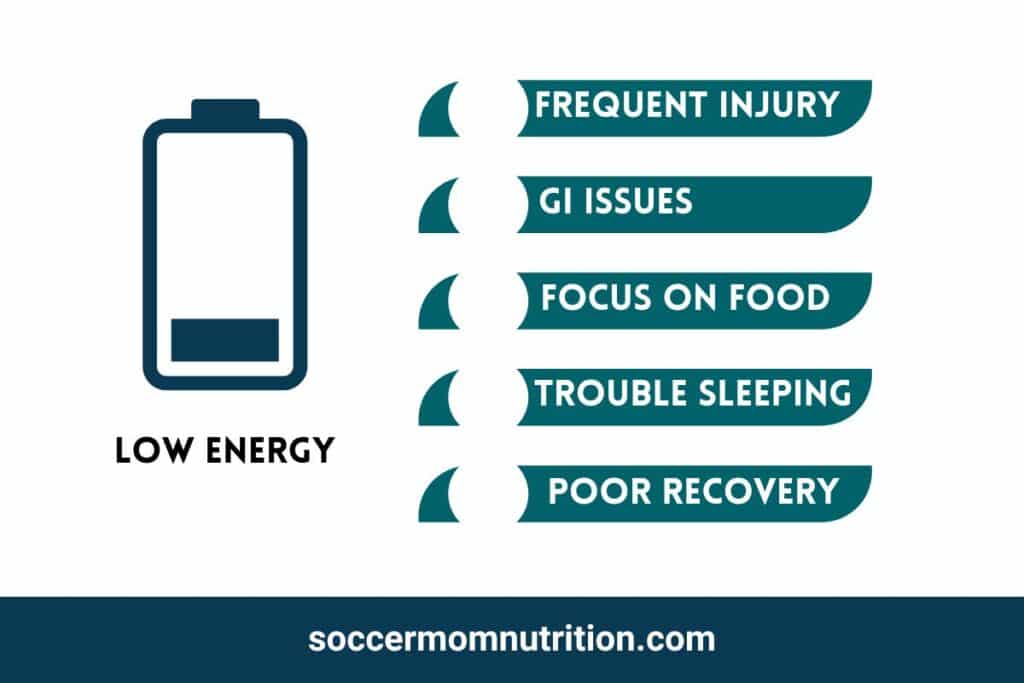Underfueling: What Every Athlete Needs to Know
Are you an athlete who trains hard but feels like you’re not performing at your best? Do you struggle with frequent injuries, digestive issues or sleep problems? If so, you might be underfueling your body.
Underfueling is a common problem that affects many athletes, especially those who participate in high-intensity or endurance sports. It occurs when you don’t consume enough calories to support your energy expenditure and recovery.
This can lead to a negative energy balance, which can harm your health and performance.
In this blog post, we’ll explain what under fueling is, how to identify it and how to avoid it. We’ll also share some tips on how to fuel your body properly for optimal performance.

What is athlete underfueling
Athlete underfueling is when you don’t eat enough and your energy intake doesn’t meet your energy needs for your sport. It’s often referred to as relative energy deficiency in sport (RED-S). (1)
This can happen for various reasons, such as:
- Lack of knowledge on how much and what to eat for your sport
- Not having enough time or access to nutritious foods
- Intentional dieting to lose weight or change body composition
- Disordered eating behaviors or attitudes
Underfueling results in a negative energy balance, or low energy availability, which means you’re burning more calories than you’re consuming. (2)
This can affect your performance and health in several ways, such as:
- Reducing your muscle mass and strength, causing injury
- Weakening your immune system and increasing your risk of infections
- Impairing your digestion and causing gastrointestinal distress
- Affecting your hormone levels and reproductive function
- Decreasing your bone density and increasing your risk of fractures
- Lowering your mood and mental focus
How to identify athlete underfueling
Underfueling can be hard to detect because it doesn’t always cause obvious symptoms. However, there are some signs that can indicate that you’re not eating enough for your sport, such as:
Frequent injuries
If you’re under fueling, you may experience more injuries than usual, or take longer to heal from them. This is because underfueling can reduce your muscle mass and strength, weaken your immune system and impair your tissue repair.
GI distress
Underfueling can also affect your digestion and cause gastrointestinal distress. You may experience stomach pain, bloating, gas, nausea or diarrhea during or after exercise. This can interfere with your nutrient absorption and hydration status.
Focus on food
If you’re under fueling, you may develop an unhealthy obsession with food. You may constantly think about what you should or shouldn’t eat, count calories or macros, restrict certain foods or food groups or binge eat.
This can lead to disordered eating patterns, which can have serious health consequences.
Trouble sleeping
Sleep is crucial for recovery and performance, but underfueling can affect your sleep quality. You may have trouble falling asleep or staying asleep, or feel tired and groggy in the morning.
This can affect your energy levels, mood, and cognitive function.
Loss of menstrual cycle
Female athletes who are under fueling may experience a loss of their menstrual cycle, known as amenorrhea. This is a sign that your body is not getting enough energy to support your reproductive function.
This can have negative effects on your bone density and overall well-being. You may have heard this called the female athlete triad. (3)

How to avoid athlete underfueling
The best way to avoid underfueling is to eat enough calories to match your energy expenditure and recovery needs. This amount you need to eat depends on several factors, such as:
To estimate how many calories you need per day, you can use an online calculator or consult with a sports dietitian or nutritionist. They can help you create a personalized nutrition plan that suits your sport and goals.
General tips to avoid underfueling
Eat a balanced diet that includes a variety of foods from all food groups: carbohydrates, protein, fat, vitamins, minerals and fluids. Use the performance plate method to ensure you’re eating enough food to match your activity needs.
Eat regularly throughout the day: Aim for three main meals and two to three healthy snacks per day. Don’t skip meals or go longer than four hours without eating. Make sure to eat a bedtime snack as well, especially if you have a game the next day.
Eat before and after exercise: Have a snack or meal that contains both carbohydrates and protein within two hours before and after exercise. This will help you fuel your performance and recovery.
Hydrate well: Drink enough fluids to stay hydrated before, during and after exercise. Aim for about 2 to 3 liters of water per day, and more if you sweat a lot or exercise in hot or humid conditions.
You can also drink sports drinks or electrolyte solutions to replenish your fluids and electrolytes.
Monitor your weight and body composition: Track your weight and body fat percentage regularly to see if you’re maintaining, gaining, or losing weight or muscle mass.
If you notice any significant changes, adjust your calorie intake accordingly or seek professional advice.
Listen to your body: Pay attention to how you feel physically and mentally. If you experience any signs of underfueling, such as fatigue, hunger, irritability, or poor performance and recovery, increase your calorie intake or take a rest day.
Don’t ignore or push through the symptoms, as they can worsen over time.
Final thoughts
Underfueling is a common problem that can affect your health and performance as an athlete. To avoid it, you need to eat enough calories to support your energy expenditure and recovery needs. This will help you optimize your performance and well-being.
Join our mailing list and get our FREE Pre-Activity Fueling Guide.
Stephanie Magill, MS, RD, CD, FAND has over 22 years of experience in public health and nutrition. As a performance registered dietitian nutritionist, Stephanie specializes in sports nutrition and provides simple and actionable information so that athletes can be well fueled for high performance on and off the field. Stephanie has a Master’s Degree in Nutrition and is a Fellow of the Academy of Nutrition and Dietetics.

